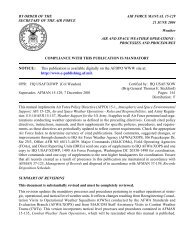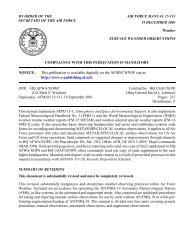Joint Metoc Handboo - IHMC Ontology and Policy Management
Joint Metoc Handboo - IHMC Ontology and Policy Management
Joint Metoc Handboo - IHMC Ontology and Policy Management
Create successful ePaper yourself
Turn your PDF publications into a flip-book with our unique Google optimized e-Paper software.
9-US Army<br />
> Prevailing winds<br />
> Location of artillery units<br />
> Communications facilities <strong>and</strong> capabilities<br />
> Administrative support<br />
> Local security<br />
- ARTYMET sections are equipped to perform electronic <strong>and</strong> visual upper-air<br />
observations employing a balloon-sounding method. Normally, they are equipped<br />
with FM radio <strong>and</strong> Multiple Subscriber Equipment (MSE) communications.<br />
- ARTYMET sections in a corps area communicate with each other <strong>and</strong> exchange<br />
data on the corps ARTYMET net. Artillery obtain meteorological data by<br />
monitoring this net at specified times. DIVARTY units may also obtain<br />
meteorological data over the DIVARTY combat net radio (CNR) system using the<br />
Single-Channel Ground <strong>and</strong> Airborne radio System (SINGARS), a secure FM radio<br />
with data h<strong>and</strong>ling capability, <strong>and</strong> through tactical fire direction computer system<br />
(TACFIRE) automatic data processing (ADP) systems.<br />
- ARTYMET sections sound the atmosphere to heights of 98,424 feet (30,000<br />
meters), day or night, <strong>and</strong> in all types of weather except during severe surface<br />
winds. A limiting factor is time required for a sounding balloon to reach a required<br />
height. Where high altitude soundings <strong>and</strong> several types of messages are required,<br />
meteorological sections are capable of sounding the atmosphere every 4 hours. A<br />
meteorological section in position is capable of producing a ballistic message for<br />
light artillery 30 minutes after releasing the balloon. The minimum time required<br />
to produce a maximum height fallout message is about 2 hours. If electronic<br />
equipment fails, sections have an alternate, but limited, method of measuring<br />
upper-air winds by observing pilot balloons (PIBALs). Upper-air densities <strong>and</strong><br />
temperature are computed by using climatological tables with the current surface<br />
values of each element (assuming there is no low cloud cover).<br />
- All ARTYMET sections are trained to produce:<br />
> Ballistic meteorological messages<br />
> Computer meteorological messages<br />
> Fallout messages<br />
> Upper-air data for transmission to AWN / MIST<br />
> Target acquisition meteorological messages<br />
> Limited surface weather observations<br />
• Air Traffic Service (ATS) Units. ATS units may have weather observing instruments to<br />
measure surface pressure, temperature, <strong>and</strong> surface wind velocity. In addition,<br />
aircrews, flight operations personnel, <strong>and</strong> control tower operators visually estimate<br />
horizontal visibility <strong>and</strong> obstructions to visibility, as well as observe <strong>and</strong> report such<br />
special phenomena as lightning, thunderstorms, <strong>and</strong> tornadoes. Control tower<br />
operators assigned to ATS units are trained by Air Force weather personnel to take<br />
limited weather observations.<br />
9-6




